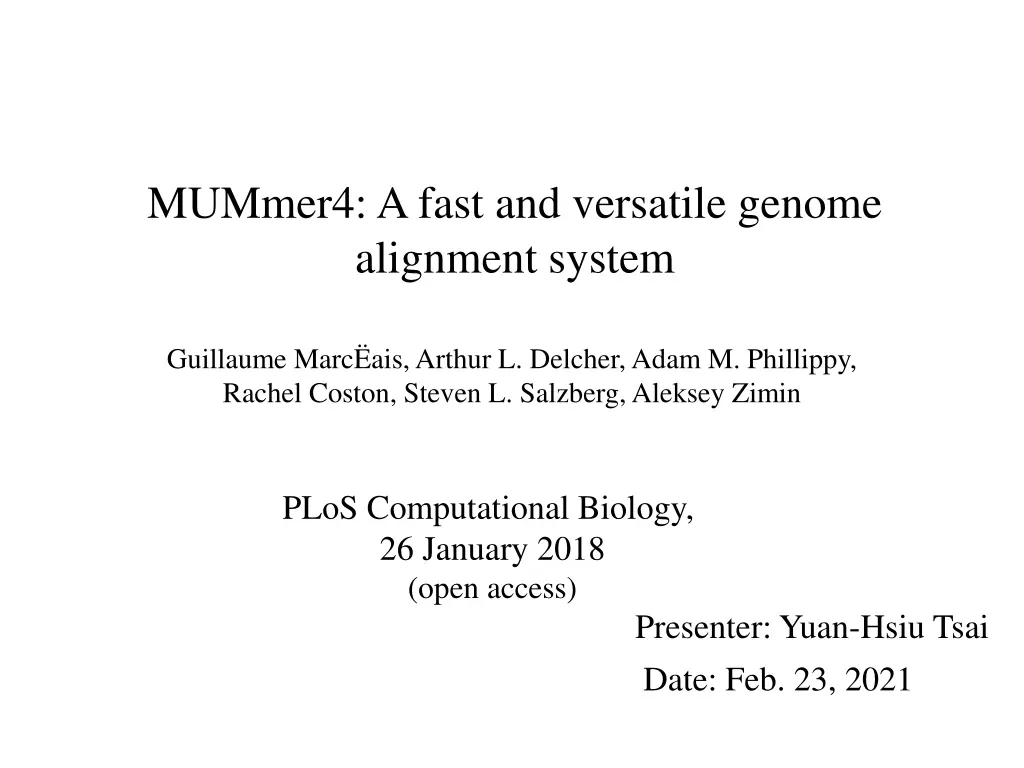
MUMmer4: Fast and Versatile Genome Alignment System
"Discover the advancements of MUMmer4, a powerful genome alignment system that offers improved speed and versatility for aligning large genomes and sequence data sets. Learn about its enhanced capabilities, including handling alignments of human and chimpanzee genomes, and its compatibility with scripting languages. Dive into the details of MUMmer4's improved features and applications in genomics." (292 characters)
Download Presentation

Please find below an Image/Link to download the presentation.
The content on the website is provided AS IS for your information and personal use only. It may not be sold, licensed, or shared on other websites without obtaining consent from the author. If you encounter any issues during the download, it is possible that the publisher has removed the file from their server.
You are allowed to download the files provided on this website for personal or commercial use, subject to the condition that they are used lawfully. All files are the property of their respective owners.
The content on the website is provided AS IS for your information and personal use only. It may not be sold, licensed, or shared on other websites without obtaining consent from the author.
E N D
Presentation Transcript
MUMmer4: A fast and versatile genome alignment system Guillaume Marc ais, Arthur L. Delcher, Adam M. Phillippy, Rachel Coston, Steven L. Salzberg, Aleksey Zimin PLoS Computational Biology, 26 January 2018 (open access) Presenter: Yuan-Hsiu Tsai Date: Feb. 23, 2021
Abstract(1/2) The MUMmer system and the genome sequence aligner nucmer included within it are among the most widely used alignment packages in genomics. Since the last major release of MUMmer version 3 in 2004, it has been applied to many types of problems including aligning whole genome sequences, aligning reads to a reference genome, and comparing different assemblies of the same genome. Despite its broad utility, MUMmer3 has limitations that can make it difficult to use for large genomes and for the very large sequence data sets that are common today. In this paper we describe MUMmer4, a substantially improved version of MUMmer that addresses genome size constraints by changing the 32-bit suffix tree data structure at the core of MUMmer to a 48-bit suffix array, and that offers improved speed through parallel processing of input query sequences.
Abstract(2/2) With a theoretical limit on the input size of 141Tbp, MUMmer4 can now work with input sequences of any biologically realistic length. We show that as a result of these enhancements, the nucmer program in MUMmer4 is easily able to handle alignments of large genomes; we illustrate this with an alignment of the human and chimpanzee genomes, which allows us to compute that the two species are 98% identical across 96% of their length. With the enhancements described here, MUMmer4 can also be used to efficiently align reads to reference genomes, although it is less sensitive and accurate than the dedicated read aligners. The nucmer aligner in MUMmer4 can now be called from scripting languages such as Perl, Python and Ruby. These improvements make MUMer4 one the most versatile genome alignment packages available.
Introduction - MUMmer Data structure Suffix tree and suffix array Goal Computing global sequence alignment
Introduction - MUMmer What we need to find ? Maximal Unique Matches (MUMs) Maximal Exact Matches (MEMs)
Introduction - MUMmer How to do ?
